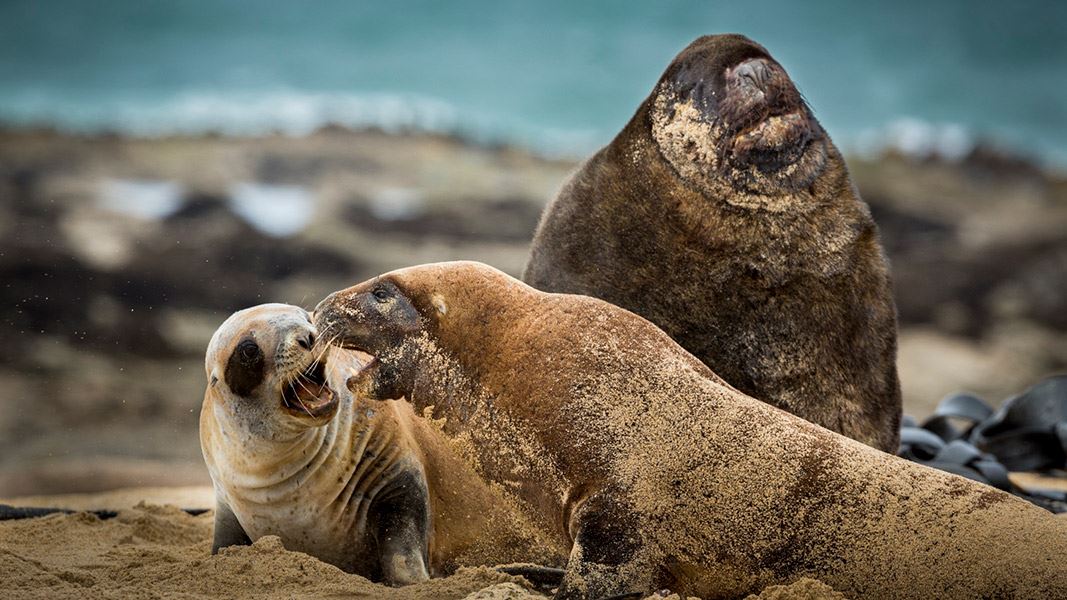Description
The New Zealand sea lion (Phocarctos hookeri) is distinguished from other New Zealand otariids by their blunt nose and short whiskers. They have sexual dimorphism, ie males and females are physically different.
Adult females (rāpoko):
- length 180–200 cm
- weight 85–160 kg
- lighter in colour, predominantly creamy grey with darker pigmentation around their flippers.
The age of maturity for females is 3–4 years and the gestation period around 10 months. The average estimated reproductive rate of adult female New Zealand sea lions is 65% per year.
Adult males (whakahao):
- length 240–350 cm
- weight 320–450 kg
- brown to black in colour with well-developed manes reaching to the shoulders.
Males are sexually mature when 5 years old, but they can't sire their first pup until they are strong enough to hold their own territory, at about 8-9 years old.
Pups:
- length: approximately 70–100 cm
- weight: 8–10 kg.
- both sexes are dark brown with paler areas around the head. Juvenile males can resemble adult females in colour and size.
Their maximum lifespan is 23 years.
Current distribution
New Zealand sea lions are not migratory, although males disperse widely over their range during the non-breeding season.
The Auckland Islands are the main breeding areas with around 68% of the entire population. The population at these islands is allocated in three different breeding colonies:
- Dundas Island, with around 1200–1700 pups born every year since 2005
- Enderby Island, with a few hundred pups a year
- Figure of Eight Island, with around 60 pups born every year since 2005.
Campbell Island was also targeted historically by sealers and is still the biggest breeding area after the Auckland Islands. The two known breeding colonies at Campbell Island (Davis Point and Paradise Point) represent around 30% of the New Zealand sea lion population.
Haul-out (leaving the water to go on land) sites are more widespread and extend from Macquarie Island to the South Island. Sea lions also haul-out on the southern parts of the mainland where colonies are being formed, and they have been seen in different spots generally around the South Island.
In 1993, a female sea lion nicknamed 'Mum' had her pup on an Otago Peninsula beach. This was the first sea lion born on the mainland in over 100 years. Nowadays, almost all new pups in Otago peninsula are related to 'Mum'.
The extension of the New Zealand sea lion's range by recolonisation of the mainland is essential to the long term survival of the species. However, it also means we will be increasingly sharing our beaches with sea lions, and we must take care not to disturb resting individuals and pups.
The progressive recolonisation of the mainland also includes Stewart Island/Rakiura, where a growing colony has being studied since 2011.
Diet
At sea New Zealand sea lion are active divers that forage on both benthic (deep sea layer) and pelagic (upper sea layer) prey. Females dive up to 129 m for about 3.9 minutes with some dive depths over 600 m for as long as 14.5 minutes.
New Zealand sea lions eat a wide variety of vertebrate and invertebrate prey. Frequently eaten species include opalfish, Munida, hoki, oblique-banded rattail, salps, octopus, squid, and crustaceans.
Adult male sea lions prey on Antarctic, subantarctic and New Zealand fur seal pups and juveniles, and occasionally penguins.
Great white sharks are the only known predator of New Zealand sea lions.
Breeding seasons
Females form into harems of up to 25 and are attended by a single dominant bull. Other males remain around the periphery and occasionally challenge the dominant bull. These challenges result in aggressive displays and fighting as the dominant bull defends his harem.
Breeding occurs over the summer months and breeding colonies occupy the same sites every year. Pupping begins in early December and ends by mid-January, when the remaining bulls disperse and the harems break up. Females give birth to a single pup every 1–2 years. Pups are born on the breeding beach but are moved by their mothers into nearby vegetation when they reach about 6 weeks old.
The females then spend the next year alternating between foraging trips to sea and periods on land suckling their pups. Pups form pods near the periphery of harems for warmth and protection while their mothers are at sea.
Pups are dependent on their mothers for milk and protection for the first year of their lives. While mothers are at sea feeding, their pups are alone. This is natural, but they are particularly vulnerable to disturbance during these periods, so keep your distance.
